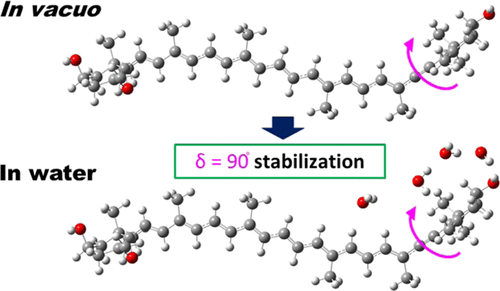当前位置:
X-MOL 学术
›
J. Phys. Chem. A
›
论文详情
Our official English website, www.x-mol.net, welcomes your
feedback! (Note: you will need to create a separate account there.)
Modeling Dynamic Conformations of Organic Molecules: Alkyne Carotenoids in Solution.
The Journal of Physical Chemistry A ( IF 2.7 ) Pub Date : 2020-03-30 , DOI: 10.1021/acs.jpca.9b11536 Simona Streckaite 1 , Mindaugas Macernis 2 , Fei Li 1, 3 , Eliška Kuthanová Trsková 4, 5 , Radek Litvin 4, 6 , Chunhong Yang 3 , Andrew A Pascal 1 , Leonas Valkunas 2, 7 , Bruno Robert 1 , Manuel J Llansola-Portoles 1
The Journal of Physical Chemistry A ( IF 2.7 ) Pub Date : 2020-03-30 , DOI: 10.1021/acs.jpca.9b11536 Simona Streckaite 1 , Mindaugas Macernis 2 , Fei Li 1, 3 , Eliška Kuthanová Trsková 4, 5 , Radek Litvin 4, 6 , Chunhong Yang 3 , Andrew A Pascal 1 , Leonas Valkunas 2, 7 , Bruno Robert 1 , Manuel J Llansola-Portoles 1
Affiliation

|
Calculating the spectroscopic properties of complex conjugated organic molecules in their relaxed state is far from simple. An additional complexity arises for flexible molecules in solution, where the rotational energy barriers are low enough so that nonminimum conformations may become dynamically populated. These metastable conformations quickly relax during the minimization procedures preliminary to density functional theory calculations, and so accounting for their contribution to the experimentally observed properties is problematic. We describe a strategy for stabilizing these nonminimum conformations in silico, allowing their properties to be calculated. Diadinoxanthin and alloxanthin present atypical vibrational properties in solution, indicating the presence of several conformations. Performing energy calculations in vacuo and polarizable continuum model calculations in different solvents, we found three different conformations with values for the δ dihedral angle of the end ring ca. 0, 180, and 90° with respect to the plane of the conjugated chain. The latter conformation, a nonglobal minimum, is not stable during the minimization necessary for modeling its spectroscopic properties. To circumvent this classical problem, we used a Car–Parinello MD supermolecular approach, in which diadinoxanthin was solvated by water molecules so that metastable conformations were stabilized by hydrogen-bonding interactions. We progressively removed the number of solvating waters to find the minimum required for this stabilization. This strategy represents the first modeling of a carotenoid in a distorted conformation and provides an accurate interpretation of the experimental data.
中文翻译:

建模有机分子的动态构象:溶液中的炔烃类胡萝卜素。
计算处于松弛状态的复杂共轭有机分子的光谱性质远非简单易行。对于溶液中的柔性分子而言,其另外的复杂性会出现,其中旋转能垒足够低,使得非最小构象可能会动态填充。这些亚稳构型在密度泛函理论计算的最小化过程中迅速放松,因此考虑它们对实验观察到的性质的贡献是有问题的。我们描述了一种在计算机上稳定这些非最小构象的策略,从而可以计算其属性。Diadinoxanthin和Alloxanthin在溶液中表现出非典型的振动特性,表明存在多种构象。在真空中进行能量计算和在不同溶剂中的极化连续体模型计算,我们发现了三个不同的构型,其端环的δ二面角为ca。相对于共轭链平面的角度为0、180和90°。后者的构型(非全局最小值)在为其光谱特性建模所需的最小化过程中不稳定。为了解决这个经典问题,我们采用了Car-Parinello MD超分子方法,其中将二恶黄质被水分子溶剂化,从而使亚稳构型通过氢键相互作用而稳定。我们逐渐去除了溶剂化水的数量,以找到稳定所需的最低限度。该策略代表了变形构象的类胡萝卜素的第一个建模,并提供了对实验数据的准确解释。
更新日期:2020-03-30
中文翻译:

建模有机分子的动态构象:溶液中的炔烃类胡萝卜素。
计算处于松弛状态的复杂共轭有机分子的光谱性质远非简单易行。对于溶液中的柔性分子而言,其另外的复杂性会出现,其中旋转能垒足够低,使得非最小构象可能会动态填充。这些亚稳构型在密度泛函理论计算的最小化过程中迅速放松,因此考虑它们对实验观察到的性质的贡献是有问题的。我们描述了一种在计算机上稳定这些非最小构象的策略,从而可以计算其属性。Diadinoxanthin和Alloxanthin在溶液中表现出非典型的振动特性,表明存在多种构象。在真空中进行能量计算和在不同溶剂中的极化连续体模型计算,我们发现了三个不同的构型,其端环的δ二面角为ca。相对于共轭链平面的角度为0、180和90°。后者的构型(非全局最小值)在为其光谱特性建模所需的最小化过程中不稳定。为了解决这个经典问题,我们采用了Car-Parinello MD超分子方法,其中将二恶黄质被水分子溶剂化,从而使亚稳构型通过氢键相互作用而稳定。我们逐渐去除了溶剂化水的数量,以找到稳定所需的最低限度。该策略代表了变形构象的类胡萝卜素的第一个建模,并提供了对实验数据的准确解释。











































 京公网安备 11010802027423号
京公网安备 11010802027423号